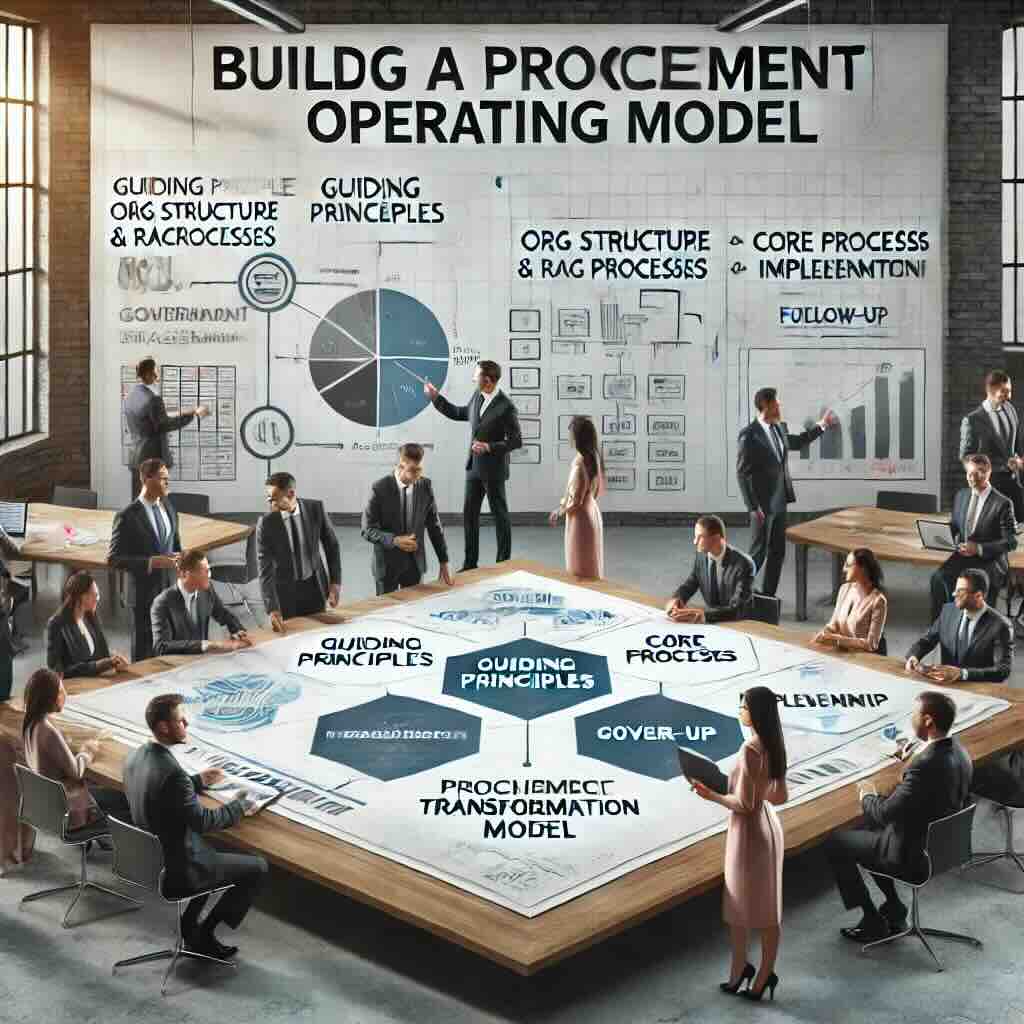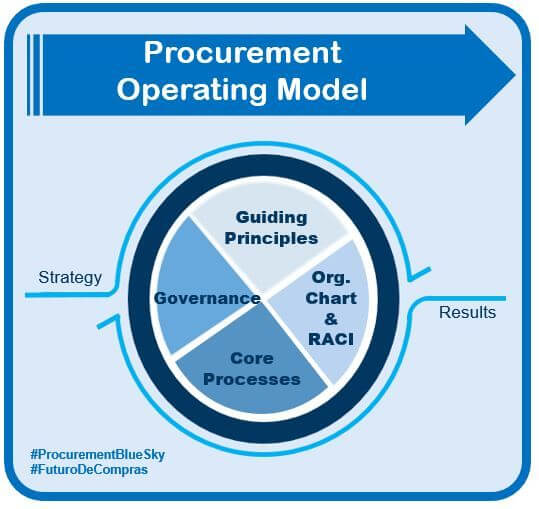In many change programs, there is an immediate & huge focus on Org. chart & associated number of FTEs: many leaders are just given few weeks in order to make a proposal. And no surprise, we just set ourselves up for a revision after few months of implementation. First one must be ready to answer the question: “What is a Procurement Operating model?”
In any Transformation Program, one of the first key activities is to build the Procurement Operating Model. /// Stéphane Morel
Contents
Designing an OPERATING MODEL should logically come after:
- STRATEGY: Proc. maturity audit, Voice of the Business, definition of an ambition & roadmap
- PEOPLE: audit of competencies & team dynamics, rethink the roles vs current org chart
- PIPELINE: draft prioritization of the key initiatives
I tend to oversimplify the work on Operating Model talking about:
- Guiding Principles
- Org. Chart/RACI
- Core Processes
- Governance
Guiding Principles:
Few years ago, it was also called Procurement Policy.
The guiding principles define in a couple of pages (max):
- Why there is a procurement organization
- Procurement scope
- Difference between transactional, tactical & strategic activities
- Key Processes, activities, roles & responsibilities
- Roles and Responsibility in relation to of the rest of the company
Org. Chart & RACI:
We define how do we organize the function based on:
- Business structure & level of centralization
- Third party spend segmentation
- Our goals & maturity roadmap
We should have the strategic conversation about:
- Localization – hubs vs countries.
- Remote work policy,
- Externalizing some parts of Procurement
We create the roles, the ‘boxes’; we calculate the nº of FTEs; we put the names.
Core Processes:
- Define & map the core Proc. processes (inputs, activities, RACI, system, outputs).
- Create a baseline & we do our best to align, alleviate, accelerate, automate.
Governance:
- Governance mechanisms
- KRAs (Key result area), KPIs of the function
- KRAs, KPIs of the transformation program
How do you build a Procurement Operating Model? How is it structured? Any tips & tricks?
Contact Mr Stéphane Morel at LinkedIn if you want to have a more extended answer to the question: “What is a Procurement Operating Model?“.
Steps when creating a procurement transformation program.
Following are the ideas from Fredrik Axelsson regarding the key steps when executing a Procurement transformation program. A procurement transformation program is a comprehensive effort to overhaul and improve the procurement function within an organization. It typically involves a series of structured and strategic steps aimed at enhancing efficiency, reducing costs, and aligning procurement processes with the overall business strategy. Here are the key steps involved in such a program. (NOTE there is NO one size fits all in this case. See theses steps as inspiration more than a guide to follow in detail):
1. Assessment and Analysis:
- Current State Assessment: Evaluate the existing procurement processes, policies, and performance metrics (and more).
- Identify Pain Points: Understand the challenges and inefficiencies in the current system. Hence, areas for improvement.
- Stakeholder Engagement: Involve key stakeholders to gather insights and understand their needs and expectations.
2. Strategy Development:
- Define Objectives: Set clear, measurable goals for the transformation (cost savings, process efficiency, supplier relationships, etc.).
- Supply chain: Develop category management and connected strategies.
- Processes, methods and tools
- Organization and roles (including Governance).
- Risk Management: Establish a framework for identifying and mitigating risks in the supply chain.
3. Create a general plan which can be adapted to new reality along the way. Examples of activities:
- Streamline Processes: Simplify and standardize procurement processes to improve efficiency.
- Policy Update: Revise procurement policies to align with best practices and organizational objectives.
- Compliance Framework: Ensure that procurement activities comply with relevant laws, regulations, and corporate policies.
- Digital Tools: Implement or upgrade procurement software systems (e.g., e-procurement platforms, ERP systems).
- Automation: Automate routine procurement tasks to reduce manual efforts and errors.
- Data Analytics: Leverage data analytics for better decision-making and performance tracking.
4. Change Management and Training:
- Stakeholder Communication: Regularly communicate with stakeholders about the changes and expected outcomes.
- Training Programs: Provide training to procurement staff and other relevant employees on new processes and systems.
- Cultural Shift: Encourage a culture of continuous improvement and strategic thinking within the procurement team.
5. Implementation and Execution:
- Pilot Testing: Start with pilot projects to test new processes and systems. Start small, de-bug and get traction is usually the most effective way top get results.
- Full-scale Rollout: Gradually expand the implementation across the organization.
- Monitoring and Adjustment: Regularly monitor the implementation and make necessary adjustments.
6. Follow up:
- Performance Review: Regularly review the performance of the procurement function against set objectives.
- Feedback Loops: Establish feedback mechanisms to continuously gather insights from stakeholders and suppliers.
- Adaptation: Be flexible to adapt and refine strategies as per changing business needs and market conditions.
Procurement transformation is a comprehensive and ongoing process. It requires commitment, resources, and strategic planning to be effective. By fining inspiration in these steps, organizations can build a more efficient, cost-effective, and strategically aligned procurement function that supports overall business objectives.
Summary
Answer to: What is a Procurement Operating Model?
In many change initiatives, there is often a rush to focus on organizational charts and the number of Full-Time Equivalents (FTEs) early on, but this approach can lead to revisions shortly after implementation. A more structured approach involves first developing a Procurement Operating Model, which serves as a foundation for any transformation program.
Key Components of a Procurement Operating Model

- Guiding Principles: These define the purpose of the procurement function, its scope, and differentiate between transactional, tactical, and strategic activities.
- Organizational Structure & RACI: This involves organizing the procurement function based on business structure, centralization, and spend segmentation, while also considering strategic elements like localization and remote work policies.
- Core Processes: Defining and mapping key procurement processes, including inputs, activities, responsibilities, and systems, to create a baseline for improvement.
- Governance: Establishing governance mechanisms, key result areas (KRAs), and key performance indicators (KPIs) for both the procurement function and the transformation program.
Steps in a Procurement Transformation Program
- Assessment and Analysis: Evaluate current procurement processes, identify pain points, and engage stakeholders to understand their needs.
- Strategy Development: Set measurable goals, develop category management strategies, and establish a risk management framework.
- General Planning: Create a flexible plan that includes process streamlining, policy updates, compliance frameworks, digital tools implementation, and automation.
- Change Management and Training: Communicate with stakeholders, provide training, and encourage a culture of continuous improvement.
- Implementation and Execution: Start with pilot testing, gradually roll out the changes, and monitor progress for necessary adjustments.
- Follow-up: Regularly review performance, gather feedback, and be ready to adapt strategies based on evolving business needs.
By following these steps and building a solid Procurement Operating Model, organizations can create a more efficient, cost-effective, and strategically aligned procurement function that supports overall business goals. More about Procurement Management.
Note: Illustration to the blogpost “What is a Procurement Operating Model?” is provided by Stéphane Morel.
